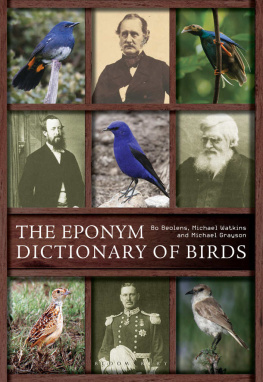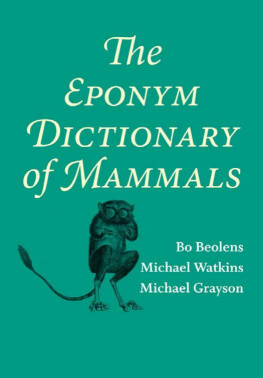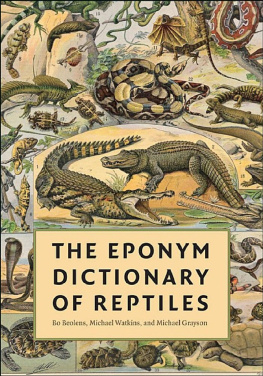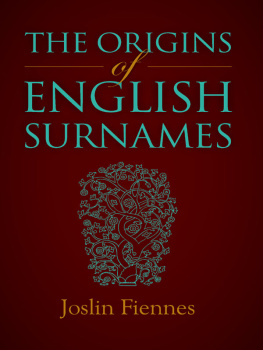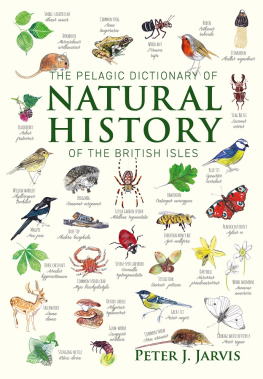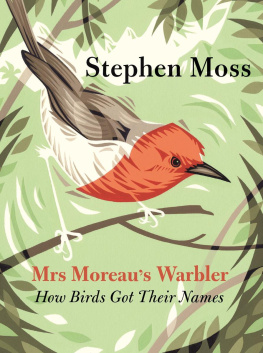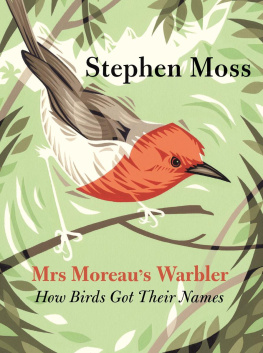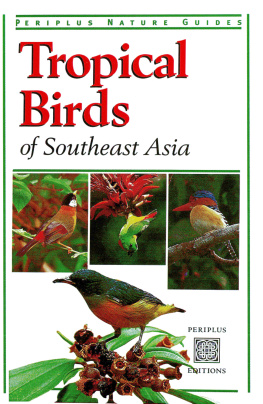
Dedication
For Suki Bryson (ne Crombet-Beolens)
17.03.7317.03.2013
Contents
Sources and Acknowledgements
This book is partly based on Whose Bird? and to some extent we were able to draw on our own previous research for this new title. In addition, we have also worked on eponym dictionaries for other faunal groups, and some of the individuals listed in these are common to this dictionary. The major change between Whose Bird? and this book is the expansion to cover eponymous scientific names rather than just vernacular names. This involved re-visiting many sources and often approaching the research from a different angle. The new challenge was to identify the individuals whose names are honoured in the binomial of a species for which the vernacular name is definitely not an eponym, or the trinomial of an obscure subspecies.
This was best achieved by reading the etymology (if any) in the original description. A certain number of these are freely available on the internet but the majority are not, and therefore much of our research was conducted in libraries. The three main libraries to which we had access were the Natural History Museum libraries in South Kensington and at Tring, and the library of the Zoological Society of London. Here we could read many of the journals and books that we had identified as the original sources of the type descriptions for the taxa concerned. Obituaries published in journals were also very useful as a source of biographical detail. When any source material could not be found there we were able to get help and advice from friends and contacts in many countries, and here we acknowledge them all.
The first group to thank are the organisations and individuals who helped us with Whose Bird?, some of whom have helped even more with this book. The second group is those who are actually mentioned in this book and who provided details of their careers and accomplishments for us to incorporate; indeed, many of them more or less wrote their own entries to save us work. Finally, there are a number of people, some of whom come into one or other of the first two categories, who gave us exceptional help, especially concerning third parties:
In Australia, Bob Forsyth; in Belgium, Robert Dowsett; in Estonia, Dr Jevgeni Shergalin; in Germany, Einhard Bezzel, David Conlin and Prof. Dr Jochen Martens; in India, Nirmala Barure (Reddy), Librarian of the Bombay Natural History Society; in the Netherlands, Jan B. Kaiser; in Peru, Manuel A. Plenge; in South Africa, Rick Nuttall, and in Venezuela, John P. Phelps and Margarita Martnez, Curator of the Coleccin Ornitolgica Phelps, who was particularly kind in looking up journals that we could not access.
In the United Kingdom, Dr Anthony Cheke, Charles Gallimore, Michael Irwin, James Jobling, Guy M. Kirwan, A. M. Macfarlane, Amberley M. Moore, Miss O. C. Ward, and Malcolm Ellis, who unfortunately died just before this book went to the publishers.
Introduction
In the beginning
This book grew, in part, out of our experience in writing The Eponym Dictionary of Mammals and The Eponym Dictionary of Reptiles (both published by Johns Hopkins University Press), and The Eponym Dictionary of Amphibians (published by Pelagic Publishing), but primarily because Bo Beolens and Mike Watkins wrote Whose Bird? Men and Women Commemorated in the Common Names of Birds (published by Christopher Helm in 2003). However, this book is profoundly not a second edition of Whose Bird? That book was both light-hearted and limited in its scope (it dealt only with common names of full species).
This is a greatly expanded work taking in not only vernacular eponyms but also eponyms that appear in the scientific names of birds, and it covers all genera, species and subspecies that are eponymous. We have not adopted any one taxonomic authority but try, so far as is possible, to include all bird eponyms ever coined, including mistakes and those not currently in use. We include all extant and historically extinct birds and there are even a few fictitious names. We have generally excluded birds that are only found in fossil form. Our yardstick has been that if a researcher or other interested party comes across a bird name that is an eponym (or seeming one) then we should give an explanation if we can.
To give an idea of how much the scope of the work has increased, there are more than 4,100 entries in the book (including some names that appear to be eponyms but are not) covering just over 10,000 genera, species and subspecies. The original work, Whose Bird? covered only 1,124 persons and 2,246 taxa.
Who is it for?
Birders often come across bird names that include a person (such names are properly called eponyms), and their curiosity will be aroused just as ours has been. You will know of some of these birds in your home area. You are certain to come across others on a foreign trip or whilst reading the books we birders seem to accumulate in such great numbers. You may even hear of a familiar bird given an unfamiliar persons name and want to know why. If so, then this book is for you. We hope that it will help satisfy your curiosity and answer your questions.
We hope that ornithologists will find this a handy guide, especially to sort out birds named after people with identical surnames or when only forenames are used. It is customary for descriptions of new species or subspecies to give the origin or meaning of the new names coined, but some etymologies give no clear derivation, and some descriptions include no etymology. Our research has filled some of these gaps.
How to use this book
We use a number of abbreviations to describe taxonomic status, etc.
| Alt | = | Alternative common name |
| b. | = | born |
| d. | = | died |
| DNF | = | Dates not found |
| fl. | = | flourished (i.e. active in his/her profession) |
| JS | = | Junior synonym of |
| NCR | = | Not currently recognised |
| NRM | = | Now regarded as monotypic |
| NPRB | = | Name preoccupied; replaced by |
| q.v. | = | quod vide (refers to an entry in this book of that person) |
| SII | = | Sometimes included in |
| sp. | = | species |
| ssp. | = | subspecies |
| Syn | = | Synonymous with |
| NUI | = | Now usually included in |
In the text the following abbreviations are widely used:
| AMNH | = | American Museum of Natural History, New York |
| AOU | = | American Ornithologists Union |
| ANWC | = | Australian National Wildlife Collection |
| BOC | = | British Ornithologists Club |
| BOU | = | British Ornithologists Union |
| BMNH | = | British Museum (Natural History), now the Natural History Museum |
| BTO | = | British Trust for Ornithology |
| CSIRO | = | Commonwealth Scientific and Industrial Research Organisation |
| MNHN | = | Musum National dHistoire Naturelle, Paris |
| RAOU | = | Royal Australasian Ornithologists Union |
| RSPB | = |
Next page
